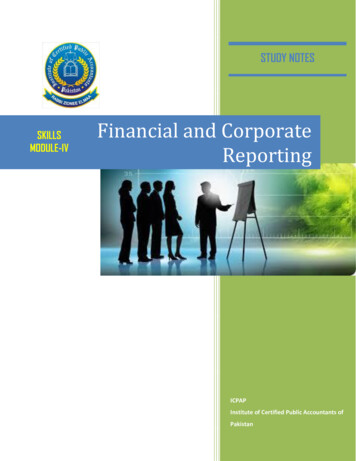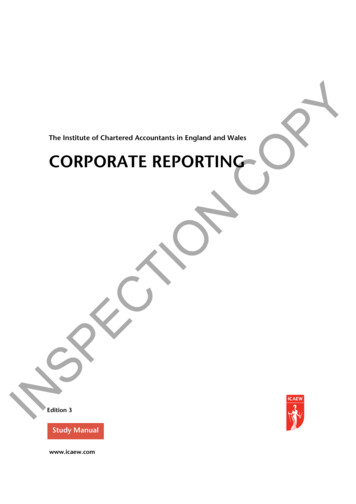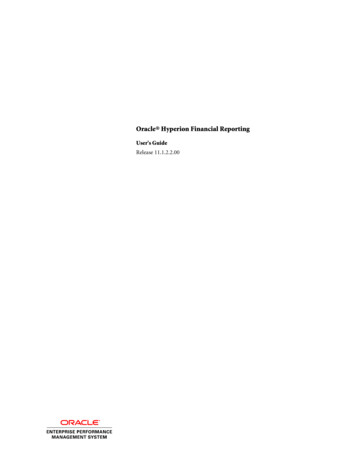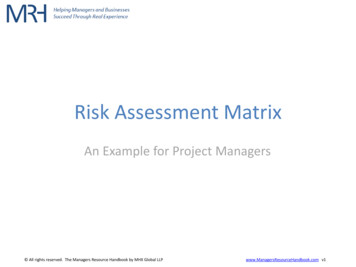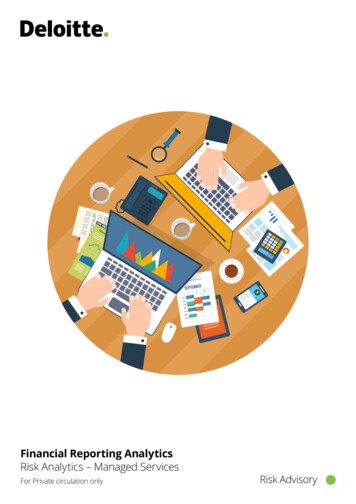
Transcription
Financial Reporting AnalyticsRisk Analytics – Managed ServicesFor Private circulation onlyRisk Advisory
Financial Reporting Analytics Risk Analytics – Managed ServicesOverviewIntroductionToday's finance function is experiencinga multitude of challenges, particularly asits operating environment gets complexand dependent on data from systems.Traditional methods to review theunderlying transactions for financial close,and activities to quality check and overseethese reconciliations, are thus gettingincreasingly error prone, slow, and difficultto deliver, as well as moreresource-intensive.analysis of the GL movements, integratingfinancial data from multiple source systemsand presenting it to users over the web viainteractive reporting dashboards.Monitoring and controlling the behaviour offinancial entries regularly not only helps thebusiness have a smooth financial close butalso highlights the potential control failuresand frauds at the transaction level, helpingthe clients mitigate these risks in advanceand formulating controls to minimizeuncertainty at financial close.Now more than ever, the Finance functionneeds to embrace cutting-edge, analytictechnologies to build and sustain moreefficient and effective control over theirincreasingly complex business activities.It becomes critical to analyze the financialentries captured in the system and tounderstand the accounting behaviorand trends.Deloitte Risk Analytics SolutionOur teams help design, implement, andembed technology, enabling our clientsto identify, assess, and prioritize risks andseek-in actions more quickly. As they doso, they seek-in a faster and more reliableAd-hoc to Technology-DrivenCompanies spend hundreds of manhours in completing reconciliations;however, they are unable to access keyinformation without adding hundredsof more hours without technology.Organizations spend huge amountson the best ERP systems to record andtrack transactional data, but rely onmanual processes to make sure thatthe information is valid, correct, andappropriate.2Financial Reporting Analytics
Financial Reporting Analytics Risk Analytics – Managed ServicesFinancial Reporting AnalyticsFRA is a proprietary tool by Deloittewhich leverages technology toautomate the process of journal entryanalysis.Current Challenges High volumes of complex issues presentin reconciling certain GL codes aretoo often dealt with via informal, oftenspreadsheet-based, finance reconciliationactivities. Establishing clear ownership andaccountability for closing each individualGL account. 'Fire fighting' approach, hence littleinvestment in proactive root causeanalysis and fix activities. Increasing compliance, regulatory andexternal reporting expectations areputting pressure on resources dealingwith "traditional" Finance activities. Key stakeholders now have a reducedtolerance for reporting errors orrestatements.Deloitte Risk Analytics SolutionThe Financial Reporting Analytics is a toolthat facilitates a comprehensive analysisof accounting entries passed in the bookkeeping system and examines unusualtransactions (Dormant users, GL Accountsanomalies, etc.) using Trial Balance (TB) andJournal Entry (JE) Data.Potential Benefits Factors Affecting the Financial CloseSeldom-Used Accounts & Users– Unusually High/Low Amounts– Unrelated Accounts– Large Credits to Income Statement– Large Debit to Revenue– Amounts with Round or RecurringDigits– Back/Pre-Dated Entries– Entries with Potential Keywords Highlight Data Integrity Problems– Duplicate Entries– Debit/Credit Amount NotReconciling at Document Level– Incomplete Records (MissingEntries)– Debit/Credit Amount NotReconciling at GL Account Level Get a complete turn-key solution inplace rapidly– Customize and deploy in 4 – 6weeks– Integrate and organize data acrosssystems– Leverage prebuilt analytics scriptsand integration technology– Software-as-a-Service (SaaS)delivery ModelWe are able to achieve this by integratingfinancial data from multiple source systemsand present it to users, over the web viainteractive reporting dashboards, whichempowers the key people to make quickand accurate decisions.3
Financial Reporting Analytics Risk Analytics – Managed ServicesReporting DashboardFacilitates Trends, Correlations &, andDrill-Ddown on Interactive modeDashboard OverviewDescriptive trend-based analytical insightsinto the Debit/Credit movement of thejournal entries in a given period (monthon-month) for all the account headers,such as expenses, cash, assets, payroll,etc., allowing the users to drill down tothe specific transactions occurring inthat account. Any exceptions or outliersin the movement of these balancesarehighlighted.4It allows the user to make multipleselections to compare various accountsproviding insights into the datawhichthatempowers the controllers tomake the right decisions which inturnresultss in a smooth financial closure.FRA presents the information in ananalytical format in time series to identifyrelevant patterns and the areas of controlfalilure based on Trial Balance (TB) andJournal Entries (JEs).Controllers can identify potential risksin conflicting functions such as recordpayments and post journal entry, processvendor invoice and record AP payments,recording acquisition of fixed assets, etc.User activity analysis provides the auditorwith details on Users and Transactionswho have access to conflicting businessfunctions (risks). It gives the auditor theflexibility to select user-wise transactioninformation of business functions.
Financial Reporting Analytics Risk Analytics – Managed ServicesAs company management beginsto better understand the role thatbalance sheet account reviews canplay in detecting and preventingfinancial statement misstatements,significant deficiencies and materialweaknesses, they will see the need toimprove both the timing and overallquality of these review processes.Sample Dashboard5
Financial Reporting Analytics Risk Analytics – Managed ServicesDissecting the data furtherThe monthly balance movements can besimultaneously analyzed at two levels:1. Financial Statement Level, where eachfinancial statement line (cash, revenues,cost of sales) can be analyzed on a monthlybasis.2. General Ledger Level, where the monthlybalance movement of every account can beanalyzed to identify the outliers, and henceavoid the risk of misstatements at the timeof a financial close.GL Movement AnalysisTransaction ScutinyTransaction Scrutiny provides detailsof selected transactions and enablesthe controllers to select dynamic inputparameters for further review and findingout the root cause of any misappropriationin the balance.The transactions at times are pre/postdatedpostdated to a financial periodwhich may mean that there has been amisstatement or a restatement – posing asa threat to a smooth financial close.Transaction ScrutinyThere is tangible value to be gainedby investing in improving the lastmile of finance. The intangible benefitof preserving shareholder value byreducing the negative financial impacts ofmisstatements and restatements may yieldeven higher value as CFOs sign balancesheet with more confidence.6There is also significant value to be gainedfrom improvements in last mile of financethrough efficiency. The intangible benefits,even though difficult to measure, may beeven higher: confidence in the numbers,better decision-making, and motivatedaccountants.
Financial Reporting Analytics Risk Analytics – Managed Services7
ContactRohit MahajanPresidentRisk Advisoryrmahajan@deloitte.comKedar SawalePartnerRisk Advisoryksawale@deloitte.comJohar BatterywalaPartnerRisk Advisoryjobatterywala@deloitte.comDeloitte refers to one or more of Deloitte Touche Tohmatsu Limited, a UK privatecompany limited by guarantee (“DTTL”), its network of member firms, and theirrelated entities. DTTL and each of its member firms are legally separate andindependent entities. DTTL (also referred to as “Deloitte Global”) does not provideservices to clients. Please see www.deloitte.com/about for a more detaileddescription of DTTL and its member firms.This material is prepared by Deloitte Touche Tohmatsu India LLP (DTTILLP). Thismaterial (including any information contained in it) is intended to provide generalinformation on a particular subject(s) and is not an exhaustive treatment of suchsubject(s) or a substitute to obtaining professional services or advice. This materialmay contain information sourced from publicly available information or otherthird party sources. DTTILLP does not independently verify any such sources andis not responsible for any loss whatsoever caused due to reliance placed oninformation sourced from such sources. None of DTTILLP, Deloitte ToucheTohmatsu Limited, its member firms, or their related entities (collectively, the“Deloitte Network”) is, by means of this material, rendering any kind of investment,legal or other professional advice or services. You should seek specific advice ofthe relevant professional(s) for these kind of services. This material or informationis not intended to be relied upon as the sole basis for any decision which mayaffect you or your business. Before making any decision or taking any action thatmight affect your personal finances or business, you should consult a qualifiedprofessional adviser.No entity in the Deloitte Network shall be responsible for any loss whatsoeversustained by any person or entity by reason of access to, use of or reliance on,this material. By using this material or any information contained in it, the useraccepts this entire notice and terms of use. 2018 Deloitte Touche Tohmatsu India LLP. Member of Deloitte ToucheTohmatsu Limited
analysis and fix activities. Increasing compliance, regulatory and external reporting expectations are putting pressure on resources dealing with "traditional" Finance activities. Key stakeholders now have a reduced tolerance for reporting errors or restatements. Deloitte Risk Analytics Solution The
